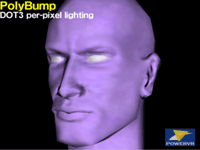At the Symbian Smartphone show we spoke to Mikael Nerde, Head of the Developer Program and Content Planning at Sony Ericsson, about some of Sony Ericsson's more recent Symbian and UIQ announcements. Although there were no device announcements it was clear Sony Ericsson was very committed to UIQ (reinforced by the recent acquisition). However there were a number of technical and marketing related announcements that were largely lost in the wider news around the show.
These included an announcement of location-free support for the P990 and an early insight into how the UIQ 3 application market was performing. However perhaps the most significant of thse was the formal announcement about support for hardware accelerated 3D graphics through OpenGL ES for Sony Ericsson's UIQ 3 phones (M600, P990 and W950). This uses Imagination Technologies' PowerVR MBX Lite based 3D hardware acceleration which is included in the Sony Ericsson P990, M600 and W950 UIQ 3-based phones.
OpenGL ES (OpenGL for Embedded Systems) is a subset of the OpenGL 3D graphics API designed for embedded devices such as mobile phones, PDAs, and video game consoles. In addition to be supported by UIQ 3 OpenGL ES has also been chosen as the official graphics API used for PlayStation 3 gaming platform development, which gives you some idea of its pedigree.
To the consumer what this means is better looking games for your phone. In more details it means that Sony Ericsson’s UIQ phones have a separate graphics processor which can be used by developers to handle the graphics workload thus freeing up the main processor for other uses and giving better overall performance. This has particular resonance in the mobile world of limited processor power. Hardware accelerated graphics will act as an enabler for next generation gaming on mobile just as it did in the PC environment.


The advantage of using OpenGL ES in conjunction with hardware accelerated graphics is that there is a very significance performance jump. The most important aspect of this is "filling power". The CPU no longer has to take care of rendering each pixel, that is done by the graphics process, and consequently not only does graphic processing happen more quickly (a dedicated graphics processes much more efficient) more of it can happen. This means it is possible to 'push' more polygons and the graphics therefore appear less blocky and more detailed. More details on the buts and bolts of this is available on the Sony Ericsson site.
The most obvious application for OpenGL on UIQ phones is in gaming. With OpenGL is should be possible to create graphically rich games of a near console level quality. In the OpenGL announcement Sony Ericsson said that ti already had several partners working on entertainment titles and that these would be made available through the Sony Ericsson Application ship in due course.
However Mikael also explained that support for OpenGL would also allow for the platform to provide a mechanism for improving the overall user experience in the user interface. Traditionally OpenGL is often regarded as something that can be used for gaming, but Mikael pointed out how it has applications outside of this traditional area. Open GL enables the easier use of 3D graphics and other techniques such as alpha transparency. As a result it is likely we will see applications using OpenGL for UI functions over and above the standard offerings. This might include more attractive graphical components in applications, but also stretches to allowing developers to do things that were not possible to do before. For example a portion of an application user interface may be transparent allowing more information to be displayed on the screen at one time or for information to be shown more clearly.
Mikael said bringing Open GL into the platform offering is important because it meant that developers would ‘be able to rely on its availability’. As a standard part of the platform it is much more likely to be used; moreover it ‘encourages developers to innovate with Open GL and create product differentiation’.

Developers can access the OpenGL offering with the OpenGL ES API which is available in the OpenGL ES SDK (available as a free download from the Sony Ericsson Developer world website). The SDK acts as an add-on for the existing UIQ SDK and extensive documentation, examples and discussion groups are provided via the developer site. Sony Ericsson is supporting OpenGL in partnership with Imagination Technologies . This partnership is fairly unique in the world of mobile developer programs. Sony Ericsson has brought in Imagination Technologies because of their expertise in this area and as a result are able to offer a more complete offering to developers that might otherwise have been possible
For developers the advantages of using OpenGL ES extend beyond what it actually enables. OpenGL ES is an open standard that has been implemented on other platforms and as result it is possible to reuse code from existing projects on other others platforms; this should reduce porting costs and time to market, which is the nascent mobile world is very important.
Early indications from developers we spoke to are that the technology is 'promising' and that there are considerably performance improvements to be gained. Others were planning to look into the technology. As one developer commented to us the best thing about it was that it was being provided - it seems the common refrain of developers (among others) to 'give us the tools and we'll finish the job' remains as strong as ever!
More information:
